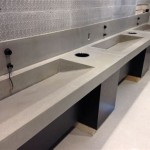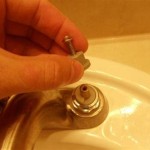How To Clean A Textured Bathroom Floor in Berlin: A Comprehensive Guide
Textured bathroom floors, popular in Berlin homes for their slip-resistant qualities and aesthetic appeal, present a unique cleaning challenge. Their uneven surfaces trap dirt, grime, and soap scum, requiring a more thorough approach than smooth tile. This article provides a detailed guide on effectively cleaning textured bathroom floors, ensuring a hygienic and visually appealing space.
The accumulation of debris in the crevices of a textured floor can lead to discoloration, unpleasant odors, and even the growth of mold and mildew. Regular cleaning is therefore essential to maintain the floor's appearance, prevent the spread of bacteria, and prolong its lifespan. The optimal cleaning frequency depends on the level of foot traffic and humidity in the bathroom; however, a weekly deep clean is generally recommended. Spot cleaning should be performed as needed to address spills and stains.
Key Point 1: Assembling the Necessary Cleaning Supplies
Before commencing the cleaning process, gathering the appropriate supplies is crucial. The selection of cleaning agents and tools will determine the effectiveness of the cleaning and minimize the risk of damage to the floor's surface. The following items are typically required:
Cleaning Solution: The choice of cleaning solution depends on the type of texture and material of the bathroom floor. For most textured tile floors, a pH-neutral cleaner is recommended. Avoid acidic cleaners, such as those containing vinegar or lemon juice, as these can etch or damage certain types of stone or grout. Alkaline cleaners, like those containing bleach, can be helpful for tackling stubborn stains or mold but should be used sparingly and with proper ventilation. Diluted dish soap is a gentle alternative suitable for everyday cleaning. Specialist tile and grout cleaners are also available, specifically formulated for textured surfaces.
Scrub Brush: A stiff-bristled scrub brush is essential for dislodging dirt and grime from the grooves and crevices of the textured floor. Choose a brush with durable bristles that can withstand repeated use. A grout brush, with its narrow head and angled bristles, is particularly useful for cleaning grout lines. An electric scrub brush can expedite the cleaning process, providing consistent and powerful scrubbing action.
Mop: A microfiber mop is ideal for rinsing and drying the floor after scrubbing. Microfiber mops are highly absorbent and effectively trap dirt and debris. Avoid using sponge mops, as they tend to push dirty water into the grout lines.
Bucket: A bucket is needed to hold the cleaning solution and rinse water.
Warm Water: Warm water helps to loosen dirt and grime, making it easier to remove.
Spray Bottle (Optional): A spray bottle can be used to apply the cleaning solution directly to the floor.
Protective Gear: Wearing rubber gloves is recommended to protect the hands from harsh cleaning chemicals. Eye protection may also be necessary when using bleach or other potentially irritating substances.
Key Point 2: Step-by-Step Cleaning Procedure
Once the necessary supplies have been gathered, the following steps should be followed to effectively clean the textured bathroom floor:
Preparation: Begin by removing all loose items from the bathroom floor, such as rugs, bath mats, and trash cans. Sweep or vacuum the floor thoroughly to remove loose dirt, dust, and debris. This will prevent the dirt from being ground into the textured surface during the scrubbing process.
Mixing the Cleaning Solution: Prepare the cleaning solution according to the manufacturer's instructions. Generally, this involves diluting the cleaning concentrate with warm water in a bucket. Avoid using too much cleaning solution, as this can leave a residue on the floor.
Applying the Cleaning Solution: Apply the cleaning solution to the floor using a mop, spray bottle, or directly from the bucket. Ensure that the entire surface is evenly coated with the solution. Allow the solution to dwell on the floor for several minutes to loosen the dirt and grime. This dwell time will vary depending on the severity of the dirt and the type of cleaning solution used. Refer to the manufacturer's instructions for the recommended dwell time.
Scrubbing the Floor: Using a stiff-bristled scrub brush, vigorously scrub the floor, paying particular attention to the grout lines and any areas with visible stains or dirt buildup. Use a circular motion to effectively dislodge dirt from the textured surface. For grout lines, use a grout brush to scrub along the length of the lines. An electric scrub brush can be used to expedite this step, providing more consistent and powerful scrubbing.
Rinsing the Floor: Once the floor has been thoroughly scrubbed, rinse it with clean water to remove the cleaning solution and loosened dirt. Use a clean mop and fresh water, replacing the water frequently as it becomes dirty. Ensure that all traces of the cleaning solution are removed to prevent residue buildup. Multiple rinses may be necessary to achieve a completely clean surface.
Drying the Floor: After rinsing, dry the floor with a clean microfiber mop or a clean, dry cloth. This will prevent water spots and help to prevent the growth of mold and mildew. Ensure that the floor is completely dry before replacing rugs or bath mats.
Addressing Stubborn Stains: For stubborn stains, such as those caused by mildew, hard water, or rust, a more targeted approach may be necessary. Apply a specialized stain remover directly to the stain and allow it to dwell for the recommended time. Follow the manufacturer's instructions carefully. Scrub the stain with a scrub brush and rinse thoroughly with clean water. Repeat as necessary until the stain is removed.
Key Point 3: Preventative Measures and Maintenance
Maintaining a clean textured bathroom floor requires ongoing effort and the implementation of preventative measures. Regular cleaning, combined with proactive steps to minimize dirt and grime buildup, will help to keep the floor looking its best for years to come.
Regular Cleaning Schedule: Establish a regular cleaning schedule to prevent dirt and grime from accumulating. A weekly deep clean is generally recommended for bathrooms with moderate foot traffic. More frequent cleaning may be necessary for bathrooms that are heavily used or prone to humidity.
Spot Cleaning: Address spills and stains immediately to prevent them from setting into the textured surface. Use a damp cloth or sponge to wipe up spills as soon as they occur. For stubborn spills, use a mild cleaning solution.
Ventilation: Proper ventilation is essential to prevent the growth of mold and mildew in the bathroom. Ensure that the bathroom is adequately ventilated by opening a window or using an exhaust fan during and after showering or bathing. This will help to reduce humidity levels and prevent the build-up of moisture on the floor.
Bath Mats and Rugs: Use bath mats and rugs to protect the floor from water and dirt. Wash bath mats and rugs regularly to prevent the build-up of mold and mildew. Choose bath mats and rugs that are specifically designed for bathroom use and are slip-resistant.
Sealing the Grout: Sealing the grout lines will help to prevent water and dirt from penetrating the grout, making it easier to clean and preventing discoloration. Apply a grout sealer according to the manufacturer's instructions. Reapply the sealer periodically as needed.
Avoid Harsh Chemicals: Avoid using harsh chemicals, such as bleach or ammonia, on a regular basis, as these can damage the textured surface and grout. Use pH-neutral cleaners or diluted dish soap for everyday cleaning. If bleach is necessary to remove stubborn stains, use it sparingly and with proper ventilation.
Consider Professional Cleaning: For heavily soiled or stained textured bathroom floors, consider hiring a professional cleaning service. Professional cleaners have the equipment and expertise to effectively clean and restore textured surfaces. They can also provide advice on preventative measures to keep the floor looking its best
By following these guidelines, residents of Berlin can effectively clean and maintain their textured bathroom floors, ensuring a hygienic, aesthetically pleasing, and long-lasting surface. Consistent cleaning and preventative measures are key to preserving the beauty and functionality of this popular flooring choice.

Steal This Look Soho House Berlin Bathroom Remodelista

Ten White Bathroom Interiors That Are Far From Boring

Lavabo Berlin Aquamar Hyperion Tiles

60 White Bathroom Timeless Look Clean And Fresh Bathrooms

Berlin Graphite Dune Countertop Washbasin 188032

Jonathan Tuckey Design And Sigurd Larsen Revamp Berlin S Michelberger Hotel Terrazzo Flooring Bathroom Decor Open

Freestanding Bath Berlin Plomberie Mascouche

Housing Bal Adhesives

Bathroom Floor From Tile Lane

Steal This Look Soho House Berlin Bathroom Remodelista
Related Posts







